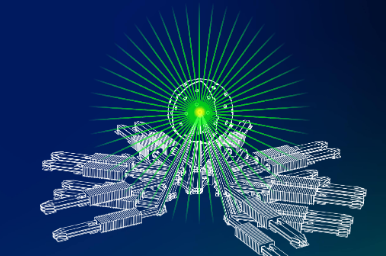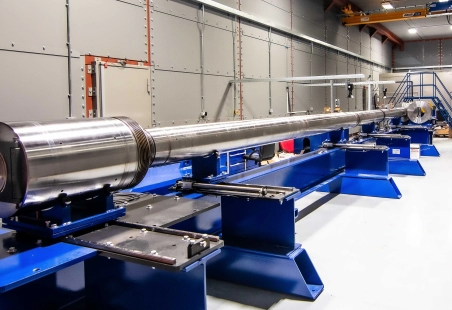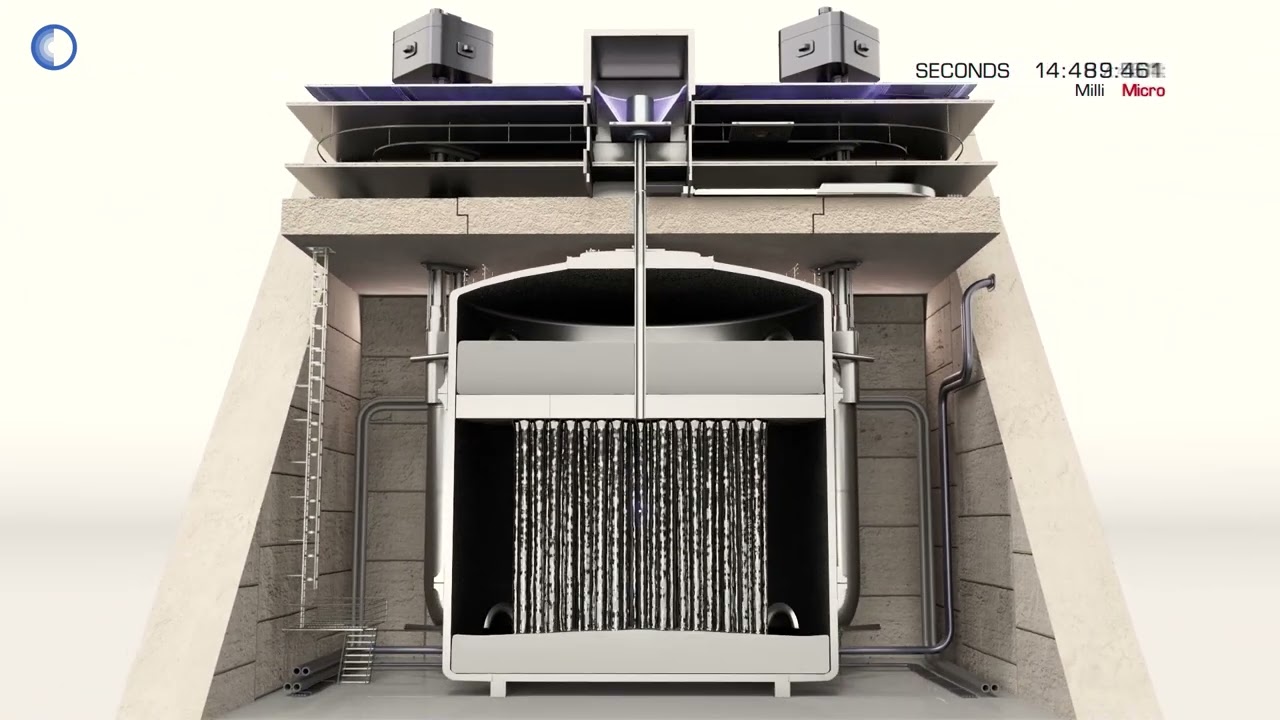Inertial Confinement Fusion

Inertial Confinement Fusion
Inertial confinement fusion (ICF) is the major technology which has competed with Magnetic Confinement Fusion (MCF) since the beginnings of controlled fusion developments since the 1950s and 1960s.
The ICF method temporarily confines the fusing plasma with the inertia of a surrounding material. Following the invention of the laser in 1960, several authors proposed using the radiative power of intense lasers to compress, heat, and confine a reacting plasma. A number of diverse ICF schemes are now being followed: indirect drive; direct drive and magnetic drive.
Until recently, most of the funding for inertial fusion has come from defence budgets because the technology is closely to fusion weapons testing. The main ICF activities are currently at the National Ignition Facility (NIF) at the Lawrence Livermore Laboratory in the USA. A similar facility exists in France near Bordeaux with the Laser Mégajoule Facility, shown in figure 1, which is part of the defence division of the CEA. As yet the NIF results are far in advance of what is openly know about the research on this device.

Figure 1. Schematic of Laser Mégajoule facility in France
National Ignition Facility
There has been much recent interest in inertial confinement fusion because of successes at the National Ignition Facility (NIF) first in 2021, Burning plasma achieved in inertial fusion followed by a paper, with more results, in 2024, Achievement of Target Gain Larger than Unity in an Inertial Fusion Experiment. Figure 1 shows the target configuration and power output for two experiments described in the latter paper.

Figure 2. Left: Schematic of the NIF indirect-drive inertial confinement approach to fusion. Laser beams enter hohlraum through entrance holes. At the centre of hohlraum, the HDC capsule is bathed in X-rays, which ablates outer surface of capsule. The pressure generated drives the capsule inward upon itself, compressing and heating fusion fuel. Bottom right: the HDC capsule and DT fuel configuration. Top right: total laser power vs time and radiation temperature Tr as a function of time for two experiments.
The "indirect drive" implosion method of the NIF experiments occurs by directing 1-2 MJ of laser energy inside an cylindrical enclosure, "hohlraum" which is shown in figure 2. This converts the laser light to x-rays and these ablate the outside of a 2mm diameter high-density-carbon (HDC) capsule which has a layer of frozen deuterium-tritium (DT) fuel on the outside and DT gas inside. Ablation from the x-ray drive accelerates the remaining ablator shell inwards to compress the DT fuel and initiate fusion.
Figure 3 shows the sequence of NIF laser implosion experiments from 2011 to 2023, indicating the increase of target gain with time.

Figure 3. NIF, target gains vs time. The colours represent different target implosion designs, and the dashed line represents the target gain = 1, the ignition criteria.
The last experiment (N221204) in figure 3, is celebrated as a breakthrough in fusion energy. This shot had an input of 2.1 MJ of laser energy and produced 3.1 MJ of total fusion yield. This demonstrates net fusion gain, and ignition, for the first time ever in a fusion device.
First Light Fusion
First Light Fusion is a private fusion company established in 2011, based in the UK, which in 2023 had $97 million accumulated funding and 93 employees. The company has a technology employing projectiles to produce shock-driven inertial fusion. The method is illustrated schematically in figure 4.

Figure 4. First Light Fusion projectile shock-driven inertial fusion method. A metallic projectile is accelerated towards a fuel capsule sitting inside an amplifier volume.
The projectile impacts a target containing fusion fuel. The target must focus the energy of the projectile, imploding the fuel to the temperatures and densities needed to make it fuse. The targets have two aspects, an amplifier and a fuel capsule. The amplifier does two things, it boosts the pressure generated by the impact of the projectile, delivering a much higher pressure to the fuel. This amplification reduces the required projectile velocity; the fuel implodes much faster than the original impact.
The companies has made a number of prototypes to demonstrate the technology. Figure 5 shows a gun prototype device.

Figure 5. First Light Fusion gun prototype "BFG".
Unlike many fusion companies, First Light Fusion has a well developed scheme for a power plant. In a power plant the target would simply be dropped into the reaction chamber and the projectile would be launched downwards though the same entrance, such that it catches up with the target at the right moment. The simple geometry of the vessel, with only one entrance hole, allows the use of a liquid lithium first wall. The video shows how the power plant would work.
Video. First Light Fusion power plant concept.
The design allows tritium self-sufficiency with pure lithium in the natural isotope balance. This is a major advantage as the only by-product is helium, and there is an established supply chain for non-isotope-separated lithium.
The planned power plant would produce ~150 MW of electricity, firing once every 30 seconds, and costing less than $1 billion.
Focused Energy
Focused Energy was founded in 2021, based in the USA and Germany. In 2023 the company has $82 million in funding and 45 employees. The paper: Focused Energy, A New Approach Towards Inertial Fusion Energy, describes the methods and technology of the company. The ambition of the company is to build a 800 MWe fusion power plant with laser implosion technology.
In Magnetic Confinement Fusion the plasma is confined at low density (1014/cm3) for a long time (hours) while in Inertial Confinement Fusion it has a very high density (1026/cm3) for very short times (around10-12 seconds). Figure 6 illustrates the different stages in ICF.

Figure 6. Inertial confinement fusion stages with irradiation of the outer layer, ablation of the outer material and implosion of the payload, central ignition, and burn and explosion
While the experiments at the National Ignition Facility use the indirect drive method where the laser hits the inside of the Hohlraum and re-radiates x-rays, the Focused Energy technology uses direct drive where the laser directly hit the fuel target. This latter method is much more efficient in transferring energy to the fuel target because, in the indirect method, only about 5% in the input laser energy ends up heating the fuel capsule. Figure 7 illustrates the two methods.

Figure 7. Different versions of laser ICF: (a) Indirect Drive, (b) Direct Drive.
A further element in the Focused Energy approach, is Fast Ignition which is illustrated in figure 8. This method performs the heating not through the compression but by means of inputting additional energy into the pre-compressed fuel.

Figure 8. Basic concepts of the central hot-spot (left) and the fast ignition (right) approaches. Fast Ignition separates the compression from the ignition phase by adding a high intensity charged particle beam to ignite the fuel in a small volume on the left side of the dense fuel assembly.
The heating is provided via protons, in the so-called Proton Fast Ignition approach. Protons penetrate deep into the target to reach the high-density region, where the hot spot is to be formed, and maximize the energy deposition at the end of their range to heat a more localized volume. The basic idea, illustrated in Figure 9, is to use multiple, short pulse lasers irradiating a thin foil that is mounted inside a cone structure to generate the igniting proton pulse. The protons are accelerated from the rear surface of the foil and are focused into the compressed fuel.

Figure 9. Schematic illustration of the Proton Fast Ignition approach, with a cone-in-shell target and proton acceleration from a curved foil inside the cone. First, the shell is compressed by a high-energy, nanosecond laser driver so that a dense fuel assembly is formed at the cone tip. Then, multiple ultra-intense short pulse laser beams generate the intense proton beam inside the cone from a curved foil. The protons stream through the cone tip into the dense D-T fuel and release most of their energy in a small volume, which leads to ignition.

Figure10. Focused Energy prototype device Super-Nova showing a potential ignition target chamber configuration. The green beams symbolize the nanosecond compression laser beams, and the blue beams symbolize the short-pulse ignition beams.

